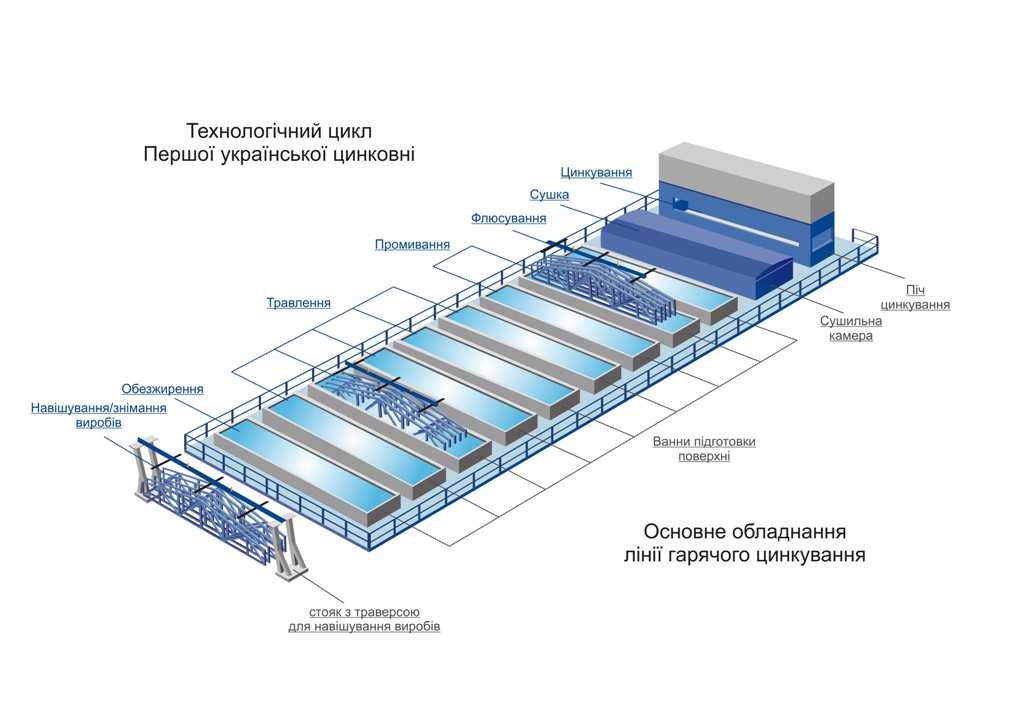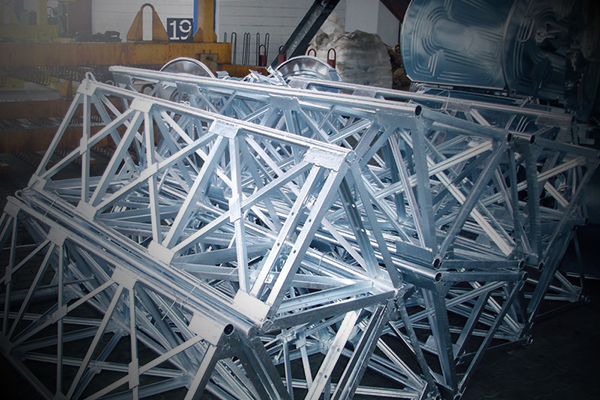Galvanizing is a reliable method to protect metal from rust. Metal products are coated with a layer of zinc so the structure lasts as long as possible, even when exposed to rain, dust, or chemicals.
The most common 2 methods are hot-dip and cold galvanizing. Each has its own advantages, disadvantages, and application nuances. More about this below.
Hot-dip galvanizing: how it works and where it’s used
This method is universal. It is widely used in construction, energy, transport infrastructure, and the gas and oil industries. It seems there is no sector where galvanized products wouldn’t be useful.
So what is hot-dip galvanizing? It’s the immersion of a metal part in molten zinc (usually with 98.5% content) at a temperature of around 450°C. This forms a dense protective coating from 40 to 100 microns thick, and in some cases even up to 200. The zinc literally fuses with the base metal, creating a durable anti-corrosion barrier.

More about our technological cycle: https://zink.com.ua/en/haryache-tsynkuvannya/.
This method is used to coat various metal structures: from power line poles and telecom towers to fences, stairs, pipelines, car parts, and frames. The coating not only protects against rust but also significantly reduces wear on components.
Although hot-dip galvanizing does not create a perfectly smooth or decorative surface, it is more than sufficient for protecting construction and industrial structures. And if aesthetics are needed, powder coating in any RAL color can be applied over the zinc.
Advantages of hot-dip galvanizing
Hot-dip galvanizing is a proven way to protect metal from corrosion. In short, here are other benefits:
- Durability comparable to stainless steel. The protective coating formed during hot-dip galvanizing doesn’t just repel moisture. It turns ordinary metal into something very close to stainless steel in terms of corrosion resistance. Such protection lasts for decades (from 20 to 65 years) — with minimal maintenance;
- Strength through molecular bonding. Zinc doesn’t just sit on top. It actually grows into the metal’s structure. This makes the bond extremely strong — the coating doesn’t crack, peel off, or get damaged during use;
- Galvanizing complex parts — protection in hard-to-reach areas. Molten zinc gets into places a brush never could: gaps, internal corners, holes. This is important for complex-shaped parts where every uncovered area is a potential rust spot;
- Protection beyond corrosion. Even if small scratches appear, hot-dip galvanizing keeps “working.” Zinc has a self-healing property within the damaged area, so small defects don’t become weak points;
- Effective in extreme conditions. Hot-dip galvanizing performs well where other coatings wear out quickly. Constant moisture, sea air, contact with soil or chemically aggressive environments — none of that is a problem. This protection is ideal for structures placed underwater, in the ground, or simply outdoors;
- Speed and production scale. The immersion method allows for processing large batches of metal, including oversized structures. It’s the perfect solution for mass production.
Disadvantages of hot-dip galvanizing
Yes, there are nuances, but most of them are no longer an issue:
- Size limitations are conditional. Previously, bath size limited the possibilities. Today — it doesn’t. Our equipment can handle metal structures up to 6500х1500х2500 mm (length x width x height). If even one of your dimensions exceeds these values, contact us. We’ll check the possibility of processing your specific structure;
- On-site processing is not possible. Galvanizing is done exclusively under production conditions. It’s not possible to “galvanize on-site”; the items must be transported to the facility;
- The price is slightly higher, but justified. Yes, hot-dip galvanizing isn’t the cheapest option. But for large volumes or complex products, it becomes the most cost-effective — one treatment lasts for years.
Cold galvanizing: pros and cons
At first glance, it seems simple. You take a special zinc-containing solution, a brush or spray gun, apply it to the metal — and done. No molten bath, no need to transport the structure to a facility. However, this method can’t always compete with hot-dip galvanizing. Let’s be honest — when is it really convenient, and when does it fall short?
Advantages of cold galvanizing
- Uniformity. Zinc is applied in a thin, clean layer without drips or streaks. This is especially important for small parts or where precision is needed;
- Thin layer. The coating is usually from 5 to 25 microns thick. This preserves the exact geometry of parts such as fasteners, electronic components, or decorative elements;
- The appearance is pleasantly neat. The surface after cold galvanizing looks more refined. That’s why this method is often chosen for furniture fittings, decorative grilles, or other visually important parts;
- And yes, it’s cheaper. For single or small-batch items, cold galvanizing is a truly budget-friendly solution.
Disadvantages of cold galvanizing
- Weaker protection. Over time, it “wears out”: the coating starts to break down, and rust returns;
- A perfectly clean surface is a must before application. Otherwise, the solution won’t adhere — and that takes extra time;
- Hard to treat complex shapes. Inner corners, deep holes, closed areas are nearly impossible to coat evenly;
- Cold galvanizing isn’t suitable for harsh environments. Moisture, salt, industrial chemicals — all of these quickly damage the thin zinc layer;
- Not ideal for large metal structures either. It’s physically hard and time-consuming. Plus, the coating wears faster under mechanical stress;
- And after 2–3 years, it’s quite likely you’ll need to recoat, so savings are questionable.
Which galvanizing method to choose: hot or cold?
Galvanizing protects metal from rust and extends the lifespan of structures. But the effectiveness of this protection depends on the chosen method — hot or cold. If you choose wisely, the structure won’t rust even after 5 years or more.
The choice depends on operating conditions, climate, access to the object, and desired service life. Let’s dive deeper.
When is hot-dip galvanizing the only viable option?
If the structure is outdoors and constantly exposed to precipitation, UV, temperature fluctuations, or, say, salty sea air — don’t take risks. Choose hot-dip galvanizing. It creates a dense, strong, multi-layered protective coating that doesn’t crack, peel, or disappear after a year or two.
Typical use cases for hot-dip galvanizing:
- power line poles, street lighting, telecom towers;
- bridges, overpasses, road infrastructure;
- metal trusses and roofing for hangars and warehouses;
- roadside safety barriers;
- piers, pontoons, docks — structures in contact with water.

When is cold galvanizing chosen?
This option is convenient when you need to treat a part right on-site, without transporting it to a facility. It also suits less aggressive conditions and small parts or temporary solutions.
Cold galvanizing is best suited when:
- furniture elements, decorative grilles, or railings are being galvanized;
- internal structures that aren’t exposed to the environment need protection;
- fasteners, nuts, bolts need coating without altering precise dimensions;
- rusted spots on metal are being repaired;
- a temporary or small structure needs affordable treatment.
But it’s important to understand: cold galvanizing is not “once and for all.” In a few years, typically between 2 and 5, the coating will need to be renewed.
Contact the First Ukrainian Galvanizing Plant! We guarantee reliable metal protection for years. We work with a German hot-dip galvanizing line, handle large structures, and always provide a warranty. We protect metal effectively, precisely, and for the long haul.